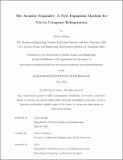| dc.contributor.advisor | Brisson, John G. | |
| dc.contributor.author | Adams, Jacob | |
| dc.date.accessioned | 2025-06-09T16:24:10Z | |
| dc.date.available | 2025-06-09T16:24:10Z | |
| dc.date.issued | 2024-05 | |
| dc.date.submitted | 2024-06-13T16:26:29.214Z | |
| dc.identifier.uri | https://hdl.handle.net/1721.1/159362 | |
| dc.description.abstract | The acoustic expander is a new expansion machine with potential applications to cryogenic refrigeration and liquefaction. Cryogenic expansion machines produce mechanical energy from the expansion of a working fluid from high-pressure to low-pressure thereby cooling the low-pressure fluid for use in refrigeration. The novelty of the acoustic expander is that the mechanical energy is transferred through a gaseous acoustic wave, as opposed to a traditional piston- or turbo-expander where the mechanical energy is transferred through a solid piston or a spinning shaft. The acoustic expander is comprised of passive reed-valves that are coupled to a resonant cavity, much like a wind instrument. The working fluid enters and exits the resonant cavity through the oscillating reed-valves which drives a standing acoustic wave in the resonant cavity. The acoustic wave carries mechanical energy from the low-temperature region to high-temperature region where the energy is then dissipated as heat to the ambient environment; this transfer of energy cools the low-pressure fluid as it exits the acoustic expander. The practical advantage of the acoustic expander over piston- or turbo-expanders is the absence of dynamic sliding seals or complex moving parts at cryogenic temperatures.
This dissertation presents a first principles thermodynamic model of the acoustic expander and describes the behavior of the coupled reed-resonator system. The model reveals that flow blow-by through the reed-valves at large pressure differentials is a primary loss mechanism. Several proof-of-concept prototypes were constructed, with both a single reed-valve and a double reed-valve, demonstrating isentropic expansion efficiencies between 40% to 50% at pressure ratios up to 2.5. These experiments incorporated the acoustic expander with a recuperative heat exchanger, reaching temperatures of -62 C (211 K) with vacuum insulation and air working fluid. The cooling power of these prototypes is between 50 to 150 Watts at room temperature with a mass flow rate of 1 to 3 g/s. Instabilities that cause the acoustic expander to shut-off and reed-valve fatigue are identified as key challenges. Future work may address these challenges and integrate the acoustic expander into cryogenic cooling systems for the refrigeration of superconducting magnets or quantum computers. | |
| dc.publisher | Massachusetts Institute of Technology | |
| dc.rights | In Copyright - Educational Use Permitted | |
| dc.rights | Copyright retained by author(s) | |
| dc.rights.uri | https://rightsstatements.org/page/InC-EDU/1.0/ | |
| dc.title | The Acoustic Expander: A New Expansion Machine for Use in Cryogenic Refrigeration | |
| dc.type | Thesis | |
| dc.description.degree | Ph.D. | |
| dc.contributor.department | Massachusetts Institute of Technology. Department of Nuclear Science and Engineering | |
| dc.identifier.orcid | 0009-0000-7542-6071 | |
| mit.thesis.degree | Doctoral | |
| thesis.degree.name | Doctor of Philosophy | |
